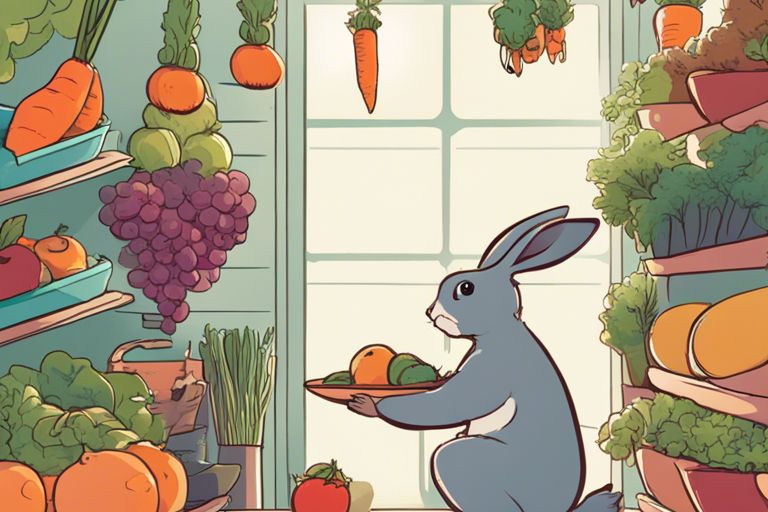Acquainting your rabbit with fresh fruits and vegetables can be a beneficial addition to their diet, but it’s crucial to proceed with caution. Some fruits and vegetables can be harmful to rabbits, so a slow and careful introduction is essential. Begin by offering small, bite-sized portions of rabbit-safe fruits and vegetables, such as carrots, lettuce, and apples. Monitor your rabbit’s response and gradually increase the variety of fruits and vegetables offered. Keep in mind that introducing new foods too quickly can cause digestive issues, so it’s important to be patient and observant. By following these steps, you can safely introduce your rabbit to a wider range of nutritious foods.
Understanding Rabbit Digestion
The digestive system of a rabbit is quite different from that of a human or even other household pets. Understanding how your rabbit’s digestive system works is essential in introducing them to fresh fruits and vegetables.
Unique Aspects of Rabbit Gastrointestinal Health
Rabbits are hindgut fermenters, which means their digestive system relies heavily on a complex ecosystem of bacteria in their cecum to break down fibrous plant materials. Unlike other animals, rabbits cannot vomit and have a limited ability to expel gases, making them susceptible to gastrointestinal stasis. This is a serious and potentially fatal condition where the digestive system slows down or stops completely, leading to a buildup of harmful bacteria and gas. It’s crucial to introduce new foods slowly and monitor your rabbit’s digestion closely to prevent any issues.
The Role of Fiber and Water
Fiber is an essential component of a rabbit’s diet, as it helps maintain gut motility and prevents gastrointestinal stasis. Fresh fruits and vegetables can provide additional fiber, but it’s important to introduce them gradually to allow the rabbit’s digestive system to adjust. The high water content in fruits and vegetables is also beneficial for your rabbit’s overall hydration, but too much water-rich food can lead to loose stool or diarrhea. Monitoring the balance of fiber and water is crucial to maintaining your rabbit’s gastrointestinal health.
Selection of Fruits and Vegetables
Obviously, introducing your rabbit to fresh fruits and vegetables is an important step in providing a balanced and nutritious diet. When choosing which fruits and vegetables to give to your rabbit, it’s crucial to consider the nutritional value and potential risks associated with each item. Your rabbit’s diet should consist of a variety of fresh fruits and vegetables that are safe and beneficial for their health.
Safe Fruits for Your Rabbit
When it comes to offering fruits to your rabbit, it’s important to choose options that are low in sugar and high in fiber. Some safe fruits for your rabbit include apples, strawberries, blueberries, and bananas. These fruits are not only delicious for your rabbit but also provide essential nutrients such as Vitamin C and antioxidants. However, it’s crucial to limit the amount of fruit your rabbit consumes as excess sugar can lead to digestive issues and obesity.
Safe Vegetables for Your Rabbit
When it comes to vegetables, your rabbit’s diet should primarily consist of leafy greens. Some safe vegetables for your rabbit include romaine lettuce, spinach, kale, and cilantro. These vegetables are rich in essential nutrients such as Vitamin A and fiber, which are crucial for your rabbit’s overall health. It’s important to avoid feeding your rabbit starchy vegetables such as potatoes, as they can cause digestive problems and contribute to weight gain.
Introducing Fresh Foods to Your Rabbit
After your rabbit has become accustomed to hay and pellets, you may want to consider introducing fresh fruits and vegetables into their diet. However, it’s important to do this gradually and carefully to ensure your rabbit’s digestive system can handle the new additions. Here are some tips on how to safely introduce fresh foods to your rabbit.
Gradual Introduction
When introducing fresh foods to your rabbit, it’s important to do so gradually. Start by offering small amounts of one type of vegetable or fruit at a time. This allows you to monitor your rabbit’s reaction and prevents overwhelming their digestive system. After a few days, you can introduce another type of fresh food in small quantities. This gradual approach gives your rabbit’s digestive system time to adjust to the new foods.
Safe and Nutritious Options
Not all fruits and vegetables are safe for rabbits to eat, and some can even be harmful. It’s important to do your research and only offer safe and nutritious options to your rabbit. Some safe options include leafy greens like romaine lettuce, spinach, and kale, as well as carrots, bell peppers, and apples (without seeds). Avoid feeding your rabbit foods like avocado, potatoes, and rhubarb, as these can be toxic to rabbits.
Monitoring Your Rabbit’s Health
As you introduce fresh foods to your rabbit, it’s important to monitor their health and digestive system. Watch for any changes in their appetite, energy levels, or stool consistency. If you notice any concerning changes, it’s best to consult your veterinarian. Additionally, be mindful of the quantity of fresh foods you’re offering, as overfeeding can lead to digestive issues.
Benefits of Fresh Foods
Introducing fresh fruits and vegetables into your rabbit’s diet can provide a range of nutritional benefits. These foods are rich in essential vitamins and minerals, and can help promote overall health and well-being. However, it’s important to remember that fresh foods should only make up a small portion of your rabbit’s diet, with hay and pellets remaining the primary sources of nutrition.
By following these guidelines and being mindful of your rabbit’s digestive system and overall health, you can safely introduce fresh fruits and vegetables into their diet, providing them with a well-rounded and nutritious meal plan.














